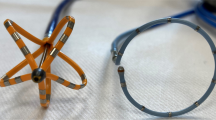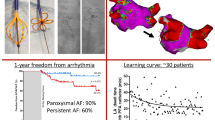Abstract
Background
A compressible lattice-tip catheter designed for focal ablation using radiofrequency or pulsed-field energies has been recently described. The objective of this study is to describe a new lattice catheter designed for single-shot pulmonary vein isolation (PVI).
Methods
This 8F catheter consists of a compressible lattice tip that is delivered over the wire and is expandable up to 34 mm (SpherePVI™, Affera Inc.). Pulsed field ablation (PFA) was applied from 6 elements using a biphasic waveform of microsecond scale (± 1.3–2.0 kV, 5 s per application). In 12 swine, the superior vena cava (SVC) and right superior pulmonary vein (RSPV) were targeted for isolation. Animals were survived for 12–24 h (n = 6) or 3 weeks (n = 6) for evaluation of short and long-term safety and efficacy parameters. PVI was evaluated immediately after ablation and at the terminal procedure. Ablation-related microbubbles were examined using intracardiac echocardiography and phrenic nerve function by pacing. The tissue was examined by histopathology.
Results
In all 12 animals, PFA resulted in successful acute isolation of the SVC and RSPV using 2.8 ± 1.1 and 3.2 ± 1.2 applications per vein, respectively. After a survival period of 23 ± 5.9 days, all targeted veins remained isolated, and the level of isolation persisted without significant regression or expansion. In one animal, SVC isolation at the level of the right atrial appendage resulted in sinus node arrest. PFA did not affect phrenic nerve function, and it was associated with a few isolated bubbles formation.
Conclusions
In this pre-clinical study, a new expandable lattice catheter designed for single-shot PVI was able to achieve rapid and durable isolation.






Similar content being viewed by others
References
Wittkampf FH, van Driel VJ, van Wessel H, Vink A, Hof IE, Grundeman PF, Hauer RN, Loh P. Feasibility of electroporation for the creation of pulmonary vein ostial lesions. J Cardiovasc Electrophysiol. 2011;22:302–9.
Neumann E, Kakorin S, Toensing K. Principles of membrane electroporation and transport of macromolecules. Methods Mol Med. 2000;37:1–35.
Neumann E, Kakorin S and Toensing K. Membrane electroporation and electromechanical deformation of vesicles and cells. Faraday Discuss. 1998:111–25; discussion 137–57.
Neven K, van Es R, van Driel V, van Wessel H, Fidder H, Vink A, Doevendans P and Wittkampf F. Acute and long-term effects of full-power electroporation ablation directly on the porcine esophagus. Circulation Arrhythmia and electrophysiology. 2017;10.
van Driel VJ, Neven K, van Wessel H, Vink A, Doevendans PA, Wittkampf FH. Low vulnerability of the right phrenic nerve to electroporation ablation. Heart rhythm. 2015;12:1838–44.
Reddy VY, Neuzil P, Koruth JS, Petru J, Funosako M, Cochet H, Sediva L, Chovanec M, Dukkipati SR, Jais P. Pulsed field ablation for pulmonary vein isolation in atrial fibrillation. J Am Coll Cardiol. 2019;74:315–26.
Yavin H, Shapira-Daniels A, Barkagan M, Sroubek J, Shim D, Melidone R, Anter E. Pulsed field ablation using a lattice electrode for focal energy delivery: biophysical characterization, lesion durability, and safety evaluation. Circ Arrhythm Electrophysiol. 2020;13:e008580.
Stewart MT, Haines DE, Verma A, Kirchhof N, Barka N, Grassl E and Howard B. Intracardiac pulsed field ablation: proof of feasibility in a chronic porcine model. Heart Rhythm. 2018.
Yavin H, Brem E, Zilberman I, Shapira-Daniels A, Datta K, Govari A, Altmann A, Anic A, Wazni O, Anter E. Circular multielectrode pulsed field ablation catheter lasso pulsed field ablation: lesion characteristics, durability, and effect on neighboring structures. Circ Arrhythm Electrophysiol. 2021;14:e009229.
Reddy VY, Anter E, Rackauskas G, Peichl P, Koruth JS, Petru J, Funasako M, Minami K, Natale A, Jais P, Nakagawa H, Marinskis G, Aidietis A, Kautzner J, Neuzil P. Lattice-tip focal ablation catheter that toggles between radiofrequency and pulsed field energy to treat atrial fibrillation: a first-in-human trial. Circ Arrhythm Electrophysiol. 2020;13:e008718.
Anter E NP, Rackauskas G, Peichl P, Aidietis A, Kautzner J, Nakagawa H, Jackman WM, Natale A, Reddy VY. An expandable lattice electrode catheter for rapid and titratable temperature-controlled radiofrequency ablation: a first-in-human multicenter trial. JACC Clin Electrophysiol. 2020;Accepted for publication.
Barkagan M, Leshem E, Rottmann M, Sroubek J, Shapira-Daniels A, Anter E. Expandable lattice electrode ablation catheter: a novel radiofrequency platform allowing high current at low density for rapid, titratable, and durable lesions. Circ Arrhythm Electrophysiol. 2019;12:e007090.
Groen MHA, van Es R, van Klarenbosch BR, Stehouwer M, Loh P, Doevendans PA, Wittkampf FH, Neven K. In vivo analysis of the origin and characteristics of gaseous microemboli during catheter-mediated irreversible electroporation. Europace. 2021;23:139–46.
Koruth JS, Kuroki K, Kawamura I, Brose R, Viswanathan R, Buck ED, Donskoy E, Neuzil P, Dukkipati SR and Reddy VY. Pulsed field ablation vs radiofrequency ablation: esophageal injury in a novel porcine model. Circ Arrhythm Electrophysiol. 2020.
Koruth J, Kuroki K, Iwasawa J, Enomoto Y, Viswanathan R, Brose R, Buck ED, Speltz M, Dukkipati SR, Reddy VY. Preclinical evaluation of pulsed field ablation: electrophysiological and histological assessment of thoracic vein isolation. Circ Arrhythm Electrophysiol. 2019;12:e007781.
van Zyl M, Ladejobi AO, Tri JA, Yasin OZ, Connolly RJ, Danitz DJ, DeSimone CV, Killu AM, Maor E, Asirvatham SJ. Reversible atrioventricular conduction impairment following bipolar nanosecond electroporation of the interventricular septum. JACC Clin Electrophysiol. 2021;7:255–7.
Calkins H, Hindricks G, Cappato R, Kim YH, Saad EB, Aguinaga L, Akar JG, Badhwar V, Brugada J, Camm J, Chen PS, Chen SA, Chung MK, Nielsen JC, Curtis AB, Davies DW, Day JD, d’Avila A, de Groot N, Di Biase L, Duytschaever M, Edgerton JR, Ellenbogen KA, Ellinor PT, Ernst S, Fenelon G, Gerstenfeld EP, Haines DE, Haissaguerre M, Helm RH, Hylek E, Jackman WM, Jalife J, Kalman JM, Kautzner J, Kottkamp H, Kuck KH, Kumagai K, Lee R, Lewalter T, Lindsay BD, Macle L, Mansour M, Marchlinski FE, Michaud GF, Nakagawa H, Natale A, Nattel S, Okumura K, Packer D, Pokushalov E, Reynolds MR, Sanders P, Scanavacca M, Schilling R, Tondo C, Tsao HM, Verma A, Wilber DJ, Yamane T. 2017 HRS/EHRA/ECAS/APHRS/SOLAECE expert consensus statement on catheter and surgical ablation of atrial fibrillation: Executive summary. Europace. 2018;20:157–208.
Verma A, Jiang CY, Betts TR, Chen J, Deisenhofer I, Mantovan R, Macle L, Morillo CA, Haverkamp W, Weerasooriya R, Albenque JP, Nardi S, Menardi E, Novak P, Sanders P, Investigators SAI. Approaches to catheter ablation for persistent atrial fibrillation. N Engl J Med. 2015;372:1812–22.
Dixit S, Lin D, Frankel DS and Marchlinski FE. Catheter ablation for persistent atrial fibrillation: antral pulmonary vein isolation and elimination of nonpulmonary vein triggers are sufficient. Circ Arrhythm Electrophysiol. 2012;5:1216–23; discussion 1223.
Funding
Dr. Anter receives research grants and speaking honoraria from Biosense Webster, Boston Scientific, and Affera Inc. He received stock from Affera Inc. The other authors report no financial disclosures.
Author information
Authors and Affiliations
Corresponding author
Additional information
Publisher's note
Springer Nature remains neutral with regard to jurisdictional claims in published maps and institutional affiliations.
Rights and permissions
Springer Nature or its licensor (e.g. a society or other partner) holds exclusive rights to this article under a publishing agreement with the author(s) or other rightsholder(s); author self-archiving of the accepted manuscript version of this article is solely governed by the terms of such publishing agreement and applicable law.
About this article
Cite this article
Yavin, H.D., Higuchi, K., Younis, A. et al. Lattice-tip catheter for single-shot pulmonary vein isolation with pulsed field ablation. J Interv Card Electrophysiol 66, 1741–1748 (2023). https://doi.org/10.1007/s10840-022-01414-7
Received:
Accepted:
Published:
Issue Date:
DOI: https://doi.org/10.1007/s10840-022-01414-7




